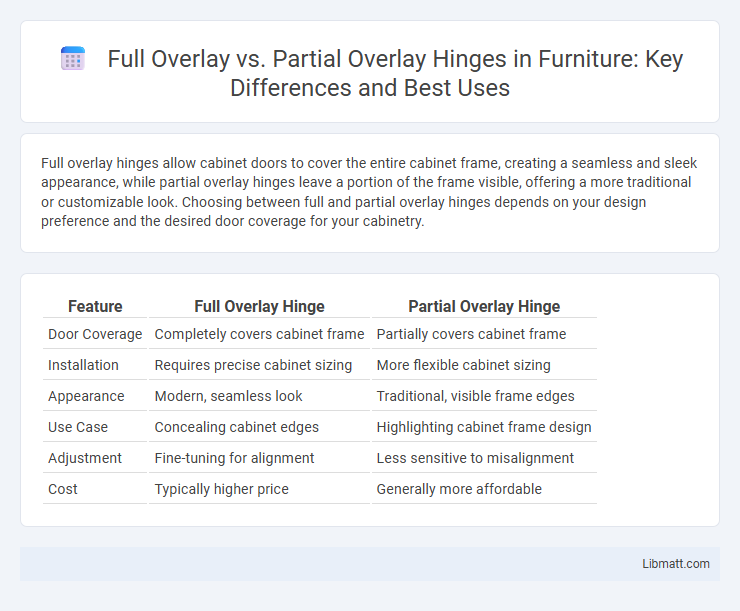Full overlay hinges allow cabinet doors to cover the entire cabinet frame, creating a seamless and sleek appearance, while partial overlay hinges leave a portion of the frame visible, offering a more traditional or customizable look. Choosing between full and partial overlay hinges depends on your design preference and the desired door coverage for your cabinetry.
Table of Comparison
| Feature | Full Overlay Hinge | Partial Overlay Hinge |
|---|---|---|
| Door Coverage | Completely covers cabinet frame | Partially covers cabinet frame |
| Installation | Requires precise cabinet sizing | More flexible cabinet sizing |
| Appearance | Modern, seamless look | Traditional, visible frame edges |
| Use Case | Concealing cabinet edges | Highlighting cabinet frame design |
| Adjustment | Fine-tuning for alignment | Less sensitive to misalignment |
| Cost | Typically higher price | Generally more affordable |
Introduction to Cabinet Hinges
Cabinet hinges are essential hardware components enabling door movement, with full overlay hinges designed to cover the cabinet frame completely, offering a seamless and modern appearance. Partial overlay hinges allow the door to cover only a portion of the frame, providing more visibility of the cabinet structure and creating a traditional look. Selecting between full overlay and partial overlay hinges depends on desired aesthetics, cabinet construction, and functional requirements.
What is a Full Overlay Hinge?
A full overlay hinge is a type of cabinet hinge designed to cover the entire edge of the cabinet frame, allowing the door to sit flush against the cabinet box for a streamlined appearance. It provides maximum coverage by overlaying the door completely over the cabinet's side panel, enhancing both aesthetics and functionality. Full overlay hinges are commonly used in modern cabinetry to create seamless, clean lines without gaps between doors.
What is a Partial Overlay Hinge?
A partial overlay hinge is a type of cabinet hinge designed to partially cover the cabinet frame, allowing the door to overlap the frame only halfway. This hinge provides a balanced aesthetic by revealing some of the cabinet frame while enabling smooth door operation. Commonly used in semi-custom cabinetry, partial overlay hinges offer a versatile solution for kitchens and furniture where both frame visibility and door coverage are desired.
Key Differences Between Full and Partial Overlay Hinges
Full overlay hinges are designed to cover the entire cabinet frame, providing a seamless and modern look by concealing the cabinet edges completely. Partial overlay hinges leave a portion of the cabinet frame visible, offering a more traditional appearance and allowing for easier alignment during installation. Your choice between full and partial overlay hinges affects both the aesthetic and functional aspects of cabinetry, influencing door mobility and overall style.
Aesthetic Impact: Full vs. Partial Overlay
Full overlay hinges provide a seamless and modern aesthetic by covering the entire cabinet frame, resulting in minimal visible gaps and a sleek appearance. Partial overlay hinges leave a portion of the cabinet frame exposed, creating a more traditional look with defined lines and contrasts. Your choice between full or partial overlay hinges significantly influences the overall visual appeal and style of your cabinetry.
Functional Considerations and Accessibility
Full overlay hinges provide superior accessibility by allowing cabinet doors to fully cover the frame, maximizing interior space and offering easier access to contents. Partial overlay hinges leave a visible gap between doors and frames, which can limit access but may be preferable for certain design aesthetics or space constraints. When selecting hinges, consider your cabinet layout and the level of convenience you need to ensure optimal functionality.
Installation Differences: Full Overlay vs. Partial Overlay
Full overlay hinges require cabinet doors to cover the entire face frame for a seamless look, demanding precise alignment and full frame access during installation. Partial overlay hinges allow the door to cover only part of the frame, simplifying installation by requiring less precise measurements and often working with face frames that have intermediate stiles. Installation differences also include varying screw hole placements and mounting plate requirements, with full overlays typically needing larger mounting plates compared to the more flexible partial overlay hinges.
Cost Comparison: Full Overlay vs. Partial Overlay
Full overlay hinges generally cost more than partial overlay hinges due to their design complexity and the amount of cabinetry material they cover, which requires sturdier construction and higher-quality materials. Partial overlay hinges are more budget-friendly, suitable for cabinets where doors only cover part of the frame, reducing manufacturing costs and installation time. Choosing between full and partial overlay hinges depends on balancing budget constraints with desired aesthetic and functional outcomes in cabinetry projects.
Pros and Cons of Full Overlay Hinges
Full overlay hinges provide a sleek, modern look by covering the cabinet frame completely, maximizing visible door space and enhancing aesthetic appeal. They offer easy installation and allow for full access to cabinet interiors, but may require precise alignment and can be less forgiving for adjustments compared to partial overlay hinges. Your choice depends on whether you prioritize a seamless design with potential installation complexity or a more adjustable hinge option.
Pros and Cons of Partial Overlay Hinges
Partial overlay hinges offer the advantage of easier installation on cabinet doors with limited overlay space, allowing for more flexible design options in cabinetry. They provide a cleaner look with less visible hardware compared to full overlay hinges, making them ideal for traditional or shaker-style cabinets. However, partial overlay hinges may limit door accessibility and reduce opening angles, which can restrict cabinet interior access and storage usability.
Full overlay vs partial overlay hinge Infographic

 libmatt.com
libmatt.com